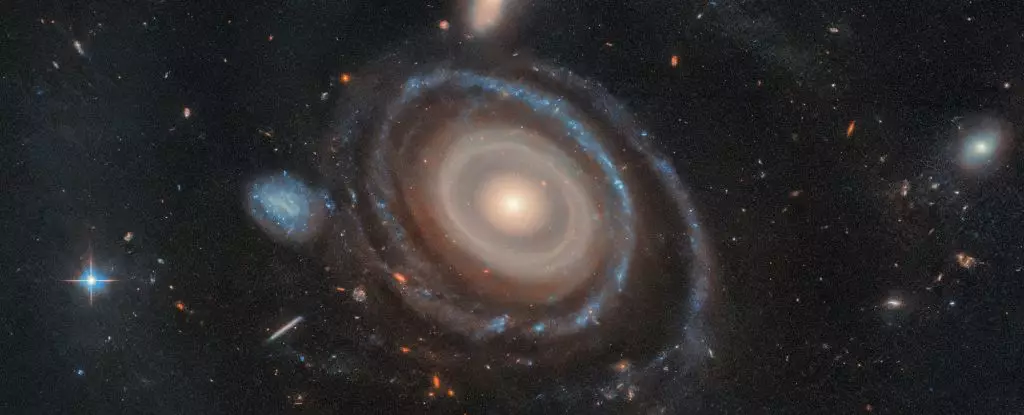In the vast expanse of the Universe, each galaxy is a marvel of its own, akin to unique fingerprints or snowflakes. While many might envision a homogenous collection of stars and planets, the reality is far more intricate. Galaxies can exhibit a constellation of forms, structures, and behaviors, making the discovery of new patterns a significant astronomical event. Among the most striking of these discoveries is a recently identified galaxy located 567 million light-years from Earth, officially designated as LEDA 1313424, but colloquially known as the Bullseye Galaxy. This unique celestial entity presents an extraordinary arrangement characterized by nine concentric rings — a phenomenon seldom observed in the cosmos.
The Bullseye Galaxy’s formation results from a violent interaction with a smaller blue dwarf galaxy that pierced through it, leading to profound cosmic repercussions. According to astronomer Pieter van Dokkum from Yale University, this event represents a pivotal moment in astronomical research: “We’re catching the Bullseye at a very special moment in time. There’s a very narrow window after the impact when a galaxy like this would have so many rings.” This statement emphasizes how transient and fleeting such cosmic phenomena are, granting researchers a rare opportunity to witness and study the aftermath of galactic confluence.
Ring galaxies, like the Bullseye, are extremely rare and typically arise from highly specific interactions. While the Universe might seem predominantly empty, it consists of interconnected filaments which can coax galaxies closer together, leading to unexpected collisions. Such interactions often yield striking but complex results, from the graceful spiral arms of traditional galaxies to the stunning circular forms seen in ring galaxies. The Bullseye’s distinctive structure provides new insight into these cosmic collisions and serves as a testament to the intricacies of galactic formations.
Observations of the Bullseye Galaxy revealed the presence of a smaller companion galaxy situated just 130,000 kilometers (approximately 80,000 miles) away. Utilizing advanced tools like the Hubble Space Telescope and the Keck Cosmic Web Imager (KCWI), astronomers uncovered crucial evidence linking this smaller galaxy to the Bullseye. As Imad Pasha from Yale explains, “We found a clear signature of gas extending between the two systems, which allowed us to confirm that this galaxy is in fact the one that flew through the center and produced these rings.” This gas serves as a crucial link, reinforcing the connection resulting from the violent encounter.
The unique data yielded by the KCWI marks an important milestone in astronomical research. By observing the gas streaming between the two galaxies, scientists gained insights into the dynamics of galaxy interactions, including how material may be drawn from one galaxy to another. Van Dokkum states, “That there is all this gas right between the velocity of one galaxy and the other is the key insight.” Such observations not only elaborate on the physical mechanics involved but also bridge theoretical models with real-life cosmic occurrences.
The Stellar Outcome
The concentric rings of the Bullseye Galaxy serve as regions of higher density where cosmic materials are amassed due to shock waves from the collision. This clumping is more than a mere spectacle; it leads to heightened star formation activities in these areas, resulting in rings that brilliantly glitter against the backdrop of space. The research team noted that the most distant ring, although faint, was identifiable only through the advanced imaging technologies. As the distance increases from the core of the galaxy, the spreading of the rings mimics theoretical predictions closely, akin to the ripples formed by a stone dropped into water, showcasing the precision of cosmic physics.
The spacing between rings represents a significant aspect of astrological studies, as it reflects how galactic materials behave following such interactions. “If we were to look down at the galaxy directly, the rings would look circular, with rings bunched up at the center and gradually becoming more spaced out the farther out they are,” Pasha elaborates. This knowledge not only contributes to our understanding of the Bullseye’s structure but also assists in refining broader astronomical models that address galactic formations and interactions.
The implications of the Bullseye Galaxy’s discovery extend beyond its immediate aesthetics. Scientists intend to use this instance to refine existing theories on galaxy collisions, enhancing their models with empirical data taken from this unique event. Furthermore, with aspirations for future observatory missions and advanced telescopes, researchers hope to uncover even more of such enchanting ring galaxies lurking in the depths of the cosmos.
The Bullseye Galaxy stands as a striking example of the universe’s complexity, showcasing the drama that unfolds within celestial environments. Its rich structure and the mechanisms behind its formation offer tantalizing glimpses into the life cycles of galaxies and the endless dance of cosmic entities. As the study of such phenomena continues, we stand on the brink of a deeper understanding of the Universe, revealing the breathtaking patterns painted across the starry canvas above.

